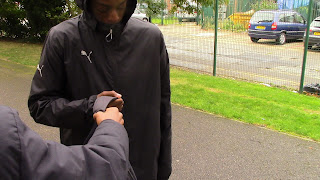Tuesday, 18 October 2016
Typography
Wednesday, 12 October 2016
Kairoes minority report analysis
This medium shot allows you to analyse the view and too gain an idea of where the scene is being set and what is happening at this point of the movie. The over-the-shoulder shot allows you too see the man analysing the fugitive on the newspaper. Also by adding the man in the shot you can infer that the man is gonna be identified as the man on the run.
This is a medium you know this as you can see his shoulders upwards. This medium close up shot allows you too analyse the police officers facial expressions as he sees the fugitive. This allows the audience too also infer that they are looking at each other in the eyes as the shot before was a
medium close up of the fugitives eyes this is called an eyeline match.
This is a wide/ establishing shot because you can see the location as you can spot the buildings surrounding the alleyway and an old car which is abandoned. In these few seconds there was loads of straight cuts too exaggerate the next bit of the movie which is a fight between the fugitive and the police.
Monday, 10 October 2016
My LRs
Post this in a new blogpost on your Media blog and complete the LR tasks/questions below.
WWW: A very solid start to Media – well done! Your fruit bowl is stunning and the selection of camera shots and angles for the photo storyboard well chosen. You’ve told a good story and identified the shots correctly. Brotherhood is also a good choice for the film poster analysis.
EBI: The clear area to develop over the next year is your written Media analysis. If you look at the last couple of questions for your opening blog post (the 10 questions) then you’re really not telling me anything about Sherlock at all. As a Media student, you need to offer SO much more than this – you think that the main thing we learn about the characters is that the actors learn their lines well? I’m certain you can do better than this. It’s a similar picture for your film poster analysis: not enough depth and detail. Over time, you’ll have to be writing in much more detailed paragraphs that offer a lot more depth of analysis in terms of key conventions and audience. This means exploring the different possible interpretations that audiences may take from a media product and really answering the question you are given.
LR: Reflect on your first month of Media. What do you feel is your strongest piece of work so far? What is your weakest? What specific skills or knowledge do you need to develop over the rest of the course?
WWW: A very solid start to Media – well done! Your fruit bowl is stunning and the selection of camera shots and angles for the photo storyboard well chosen. You’ve told a good story and identified the shots correctly. Brotherhood is also a good choice for the film poster analysis.
EBI: The clear area to develop over the next year is your written Media analysis. If you look at the last couple of questions for your opening blog post (the 10 questions) then you’re really not telling me anything about Sherlock at all. As a Media student, you need to offer SO much more than this – you think that the main thing we learn about the characters is that the actors learn their lines well? I’m certain you can do better than this. It’s a similar picture for your film poster analysis: not enough depth and detail. Over time, you’ll have to be writing in much more detailed paragraphs that offer a lot more depth of analysis in terms of key conventions and audience. This means exploring the different possible interpretations that audiences may take from a media product and really answering the question you are given.
LR: Reflect on your first month of Media. What do you feel is your strongest piece of work so far? What is your weakest? What specific skills or knowledge do you need to develop over the rest of the course?
Sunday, 2 October 2016
Kairoes photo storyboard
We picked this picture as a visible area setting the scene too our storyboard. Therefore we have chosen Wide shot so the audience knows this is our surroundings and this is where everything will take place.


This is a extreme close up we have used this so the audience know who is being called at this time in the scene and so that people know why they're calling this person.
 |
This unusual perspective makes the audience feel like they're falling with the victim as he is leaning towards the floor.
This high angle makes the victim look small as he is getting arrested and has no authority at this moment of time.
This low angle makes the policeman look big and strong as at this moment of time he has all authority over the victim.
Subscribe to:
Comments (Atom)











